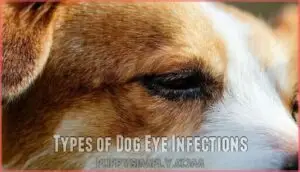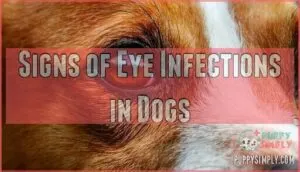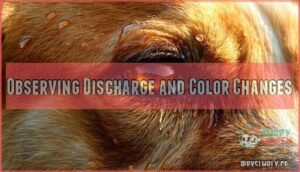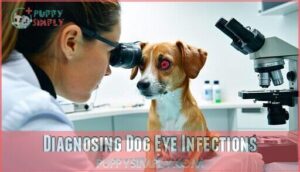This site is supported by our readers. We may earn a commission, at no cost to you, if you purchase through links.
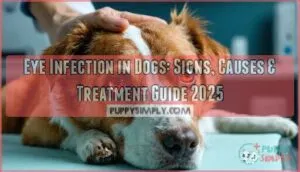
These infections stem from bacterial strains like Staphylococcus, viral causes such as distemper, fungal spores, or environmental irritants like pollen and dust.
Watch for thick discharge, excessive pawing at the eyes, light sensitivity, and squinting—clear signs your pup needs attention.
Conjunctivitis affects the eye’s surface membrane, while deeper infections like uveitis target internal structures.
Don’t wait it out; untreated infections can progress from minor irritation to serious vision problems requiring surgical intervention.
Table Of Contents
- Key Takeaways
- What Causes Eye Infections in Dogs?
- Types of Dog Eye Infections
- Signs of Eye Infections in Dogs
- How to Examine Your Dog’s Eyes
- When to See The Vet for Eye Issues
- Diagnosing Dog Eye Infections
- Treatment Options for Dog Eye Infections
- Home Care and Management Tips
- Preventing Eye Infections in Dogs
- Frequently Asked Questions (FAQs)
- Can eye infections in dogs be contagious to humans?
- What are the signs of an eye infection in dogs?
- What are the most common causes of eye infections in dogs?
- What are the best ways to prevent eye infections in dogs?
- Can eye infections spread between dogs?
- How long do eye infections last?
- Are certain dog breeds more prone?
- Can humans catch dog eye infections?
- Whats the cost of treating infections?
- Conclusion
Key Takeaways
- Watch for key warning signs – You’ll notice redness, thick colored discharge, excessive pawing at eyes, squinting, and light sensitivity that indicate your dog needs immediate veterinary attention.
- Don’t delay treatment – You should seek professional care within 48-72 hours since untreated infections can progress from minor irritation to serious vision problems requiring surgery.
- Follow medication schedules precisely – You must apply prescribed eye drops or ointments exactly as directed and complete the full treatment course to prevent antibiotic resistance and ensure complete recovery.
- Prevent future infections through daily care – You can protect your dog’s eyes by cleaning them daily with approved solutions, trimming facial hair, avoiding irritants, and scheduling annual vet checkups.
What Causes Eye Infections in Dogs?
Your dog’s eyes can become infected through multiple pathways, from microscopic invaders like bacteria and viruses to everyday irritants in their environment.
Understanding these causes helps you recognize potential threats and take preventive action to protect your pet’s vision and comfort.
Bacterial and Viral Infections
When bacterial strains like Staphylococcus and Streptococcus invade your dog’s eyes, they quickly multiply and cause painful inflammation.
Bacterial invaders transform healthy eyes into painful battlegrounds within hours
Viral loads from distemper or herpes create mucopurulent discharge that signals serious infection.
Disease transmission occurs through direct contact or contaminated surfaces, making infection control essential.
Bacterial conjunctivitis responds well to antibiotic eye drops, while viral infections require specialized antiviral treatments to prevent complications.
Fungal and Parasitic Causes
While less common than bacterial causes, fungal infections and parasites can trigger serious eye problems in your dog.
Fungal spores from the environment may infiltrate eye tissues, causing persistent inflammation that’s tough to clear.
Parasites can also create secondary infections when they irritate delicate eye structures.
Maintaining proper pet hygiene and parasite control helps prevent these stubborn canine eye diseases from developing.
Allergens and Irritants
Your dog’s eyes face daily bombardment from environmental allergens and irritants that can trigger painful inflammation.
Common culprits include:
- Air Pollution – Vehicle exhaust and industrial emissions cause chemical reactions in sensitive eye tissues
- Household Irritants – Cleaning products, perfumes, and cigarette smoke damage delicate conjunctival membranes
- Allergen Exposure – Pollen, dust mites, and mold spores trigger canine conjunctivitis and persistent eye discharge
These irritants compromise your dog’s natural tear film, leading to chronic eye problems requiring immediate attention.
Foreign Bodies and Injuries
Frequently, debris like dirt, grass seeds, or dog hair becomes lodged in your pet’s eye, triggering immediate eye inflammation and potential dog eye infection.
Physical injuries from thorns, branches, or rough play cause corneal scratches and eyelid lacerations.
Foreign objects create eye discharge while eye trauma leads to serious eye problems requiring prompt veterinary attention to prevent complications.
Tear Gland and Eyelid Abnormalities
Anatomical problems often create the perfect storm for dog eye infections.
When anatomy works against your dog, infections find their perfect opportunity
Tear Gland Dysfunction prevents proper eye lubrication, while Eyelid Deformities like entropion cause irritation and Corneal Damage.
Eye Lid Swelling from blocked Dog Tear Ducts traps bacteria, leading to persistent conjunctivitis symptoms.
These structural issues require specialized Pet Eye Care to prevent recurring Dog Eye Problems and serious infections.
Understanding canine tear production is essential in addressing the root causes of eye infections in dogs, which can lead to persistent conjunctivitis symptoms and require proper eye lubrication to prevent serious infections.
Types of Dog Eye Infections
Understanding different types of eye infections helps you recognize what’s affecting your dog’s vision and comfort.
Each type targets specific eye structures and requires different treatment approaches to restore your pet’s eye health.
Conjunctivitis (Pink Eye)
Conjunctivitis represents the most common dog eye problem, affecting the thin membrane covering your pet’s eyeball and inner eyelids.
This condition produces classic pink eye symptoms including redness, discharge, and irritation.
Bacterial and viral conjunctivitis causes require different eye infection treatment approaches.
Regular dog eye care and prompt veterinary dog eye exams help prevent complications and guarantee proper conjunctivitis treatment for maximum recovery.
Uveitis
Unlike conjunctivitis affecting the outer eye, uveitis strikes deeper structures including the iris, ciliary body, and choroid.
This serious condition causes severe ocular pain and requires immediate veterinary attention to prevent permanent vision loss.
- Uveitis symptoms include constricted pupils, light sensitivity, and blood within the eye chamber
- Eye inflammation from uveitis can lead to secondary glaucoma and cataracts if untreated
- Inner eye damage occurs in 57% of cases affecting both eyes simultaneously
Uveitis diagnosis often involves understanding eye inflammation causes to provide effective treatment.
Corneal Inflammation
Corneal inflammation affects the clear front layer of your dog’s eye, causing significant eye pain and potential vision loss.
This condition creates corneal ulcers when bacteria or trauma damage the corneal surface.
Inflammation causes from allergies, foreign objects, or injuries lead to eye swelling and irritation.
Without proper eye infection treatment, corneal scars may form, permanently affecting your dog’s sight and overall health.
Eyelid and Tear Gland Infections
Infections affecting the eyelids and tear-producing glands create significant eye swelling and discomfort for your dog.
Tear duct issues block normal drainage, causing excessive tearing and creating perfect conditions for gland infections.
You’ll notice pronounced eyelid swelling around the affected area, often accompanied by thick discharge, which can lead to corneal damage if left untreated.
These dog health issues can lead to severe consequences, requiring immediate eye infection treatment and specialized eye care for dogs.
Signs of Eye Infections in Dogs
Recognizing eye infection symptoms early helps you provide timely treatment and prevent complications that could affect your dog’s vision.
You’ll notice several telltale signs that indicate your pet’s eyes need immediate attention, from obvious discharge to subtle behavioral changes.
Redness and Swelling
When your dog’s eyes look like they’ve been through a boxing match, you’re witnessing classic signs of eye irritation and canine inflammation.
Red eye symptoms appear as bright pink or crimson tissue around the eyeball, while swollen eyelids create a puffy appearance that can partially close the eye opening, potentially leading to dog vision loss if untreated.
Eye Discharge and Crust
Thick, colored discharge signals trouble brewing in your dog’s eyes.
Normal eye discharge appears clear or slightly reddish-brown, easily wiped away with gentle cleaning.
Yellow or green discharge indicates bacterial infection requiring immediate attention.
Eye crust accumulates overnight around tear ducts, while mucus removal becomes essential for preventing further irritation.
Monitor discharge types carefully—watery tears suggest allergies, while thick secretions demand professional evaluation for proper treatment.
Pawing and Itching
When your dog constantly rubs their face or paws at their eyes, they’re telling you something’s wrong.
Pawing behavior often signals discomfort from itchy eyes or facial irritation.
This scratching can worsen the red eye condition and delay healing.
Watch for persistent eye scratching, especially if combined with discharge or swelling, as this indicates your pet needs veterinary care and possibly dog eye drops for relief.
Light Sensitivity and Squinting
You’ll notice your dog acting like a vampire avoiding sunlight when eye infections strike.
Light aversion and squinting behavior signal significant eye discomfort that shouldn’t be ignored. Eye strain from infections makes normal lighting feel overwhelming, causing your pet to seek darker spaces.
- Photophobia – Your dog avoids bright lights and prefers dimly lit areas
- Excessive blinking – Rapid, frequent blinking attempts to protect the irritated eye
- Behavioral changes – Hiding in dark corners or under furniture to escape light
This light sensitivity occurs because infected tissues become hypersensitive to normal illumination. Red eye conditions amplify this discomfort, making even gentle indoor lighting painful.
Professional veterinary care becomes essential when squinting persists, as untreated vision problems can worsen rapidly without proper dog eye drops and treatment.
Vision Changes and Cloudiness
Twenty percent of severe eye infections cause vision changes you can’t ignore.
Cloudy corneas, blind spots, and eye clouding signal serious problems requiring immediate veterinary care.
Corneal ulcers create a hazy film over your dog’s eye, while untreated infections may lead to vision loss or cataracts, permanently affecting your pet’s sight and overall canine health.
How to Examine Your Dog’s Eyes
You’ll need to examine your dog’s eyes carefully to detect early signs of infection before they worsen.
A systematic approach helps you identify redness, discharge, and behavioral changes that indicate your pet needs veterinary attention.
Checking for Redness and Swelling
Before your dog’s lunch break on the restaurant terrace, examine their eyes under good lighting.
Look for Eye Redness around the whites and inner corners, plus Swollen Eyelids that appear puffy or thick.
Eye Inflammation creates obvious color changes from normal pink to deep red.
Check both eyes systematically, noting any asymmetry that signals infection requiring immediate canine health tips from your veterinarian.
Observing Discharge and Color Changes
Discharge tells its own story when you examine your dog’s eyes closely.
Clear, watery discharge suggests allergies or minor irritation, while thick, yellow or green mucus indicates bacterial infection requiring veterinary attention.
Reddish-brown tear stains around the eyes show normal porphyrin pigment exposure but monitor for color changes that signal developing problems.
Noting Behavioral Signs of Discomfort
Your dog’s behavior provides valuable clues about pain signs and discomfort levels.
Watch for excessive eye rubbing against furniture or paws, persistent squinting even in normal lighting, and unusual whining during routine activities.
Restlessness often accompanies eye infections, creating a telling exhibition of distress.
Document this behavioral history for your veterinarian, as culture results paired with observed symptoms help determine appropriate treatment protocols for ideal eye health outcomes.
When to See The Vet for Eye Issues
While some eye problems resolve on their own, you’ll need veterinary care when symptoms worsen or involve potential vision loss.
Severe discharge, sudden cloudiness, obvious pain, or any trauma to the eye requires immediate professional attention.
Emergencies and Severe Symptoms
Beyond routine concerns, certain severe symptoms demand immediate emergency care.
Eye trauma from accidents, sudden vision loss, or corneal damage require urgent veterinary attention within hours.
You’ll recognize emergencies when your dog shows extreme pain, pupils of different sizes, or a cloudy film covering the eye.
Don’t wait—these conditions can permanently damage sight if untreated, and it’s crucial to act quickly to prevent permanent damage to your dog’s vision or cause extreme pain.
Persistent or Worsening Conditions
Some problems don’t vanish overnight like morning film on your eye.
Chronic Infections developing resistance to treatment require veterinary reassessment within 48-72 hours.
Recurrent Symptoms returning after apparent recovery suggest underlying conditions needing investigation.
Worsening discharge, increased redness, or spreading inflammation around the eye demands immediate attention.
Corneal Damage can progress rapidly without proper intervention, potentially causing permanent Vision Loss.
Vision Loss or Eye Injury
Any signs of vision loss or eye injury require immediate veterinary attention.
Blindness causes include corneal damage, cataracts, and severe infections that can permanently affect your dog’s sight.
Eye trauma from accidents, fights, or foreign objects needs urgent care.
Unlike a simple discharge that clears up, vision problems don’t resolve on their own and may worsen rapidly without professional treatment.
Diagnosing Dog Eye Infections
When your dog shows signs of an eye infection, your veterinarian will perform specialized tests to determine the exact cause and severity of the condition.
These diagnostic procedures help identify whether you’re dealing with a bacterial infection, corneal ulcer, or other eye-related issue that requires specific treatment.
Veterinary Eye Exams
During thorough veterinary eye exams, your vet uses specialized diagnostic tools and exam techniques to detect eye infections early.
These thorough assessments serve as your dog’s SAIL toward exceptional eye health, much like ships traversing Amsterdam’s maritime channels require precise instruments.
- Ophthalmoscope examination – Direct visualization of internal eye structures including retina and optic nerve
- Slit-lamp biomicroscopy – Detailed assessment of cornea, iris, and lens for abnormalities
- Tonometry testing – Measures intraocular pressure to detect glaucoma or inflammation
- External eye evaluation – Systematic inspection of eyelids, conjunctiva, and surrounding tissues
- Preventative care screening – Regular exam frequency recommendations based on breed and age factors
Fluorescein Staining and Tear Tests
When your veterinarian suspects corneal damage, fluorescein staining reveals the truth.
This painless procedure uses fluorescent dye that binds to injured corneal tissue, glowing bright green under blue light.
The Schirmer tear test measures moisture production by placing a filter strip under your dog’s eyelid.
Normal readings range 15-25mm/minute, while results below 10mm indicate dry eye syndrome requiring immediate treatment.
Increased tear production during reunions may be associated with oxytocin and bonding.
Intraocular Pressure and Dilation Tests
Advanced testing techniques reveal vital information about your dog’s eye health beyond standard visual examinations.
Your veterinarian uses specialized instruments to measure internal eye pressure and examine deep structures through pupil dilation.
- Tonometry measurements detect elevated pressure indicating glaucoma development
- Pupil dilation drops temporarily expand pupils for thorough retinal examination
- Ophthalmoscope evaluation reveals inflammation in posterior eye chambers
- Pressure readings guide treatment decisions for suspected uveitis cases
- Digital imaging documents baseline conditions for future comparison monitoring
Treatment Options for Dog Eye Infections
When your dog develops an eye infection, effective treatment depends on identifying the underlying cause and severity of the condition.
Your veterinarian will prescribe specific medications ranging from topical antibiotics to anti-inflammatory drugs, with most bacterial infections resolving within 7-10 days of proper treatment, which typically includes bacterial infections.
Antibiotics and Antiviral Medications
Most bacterial eye infections respond effectively to targeted antibiotic therapy within seven to ten days of treatment initiation.
Your veterinarian will select appropriate medications based on infection severity and bacterial culture results when necessary.
| Medication Type | Common Examples |
|---|---|
| Topical Antibiotics | Neomycin, Polymyxin B, Bacitracin |
| Fluoroquinolones | Ofloxacin, Ciprofloxacin |
| Aminoglycosides | Gentamicin, Tobramycin |
| Antivirals | Idoxuridine, Trifluridine |
| Systemic Antibiotics | Cephalosporins, Amoxicillin-clavulanate |
Dosage guidelines require strict adherence to prevent antibiotic resistance development.
Antiviral efficacy depends on early intervention, typically requiring application every four to six hours.
Medication side-effects remain minimal with proper administration, though some dogs experience temporary eye irritation.
For daily eye maintenance, saline washes are suitable.
Prophylactic use isn’t recommended without veterinary guidance.
Anti-inflammatory and Antihistamine Drugs
Many veterinarians prescribe anti-inflammatory medications to reduce painful swelling and irritation around your dog’s infected eyes.
These drugs work alongside antibiotics to provide faster relief and prevent complications.
Antihistamines help control allergic reactions that worsen eye infections.
Always follow dosage guidelines carefully, as drug side-effects can occur with long-term use or dangerous drug interactions, and be aware of potential complications.
Eye Drops, Ointments, and Washes
Topical medications serve as your primary treatment arsenal for canine eye infections. Your veterinarian will prescribe specific formulations based on your dog’s diagnosis and severity of symptoms.
Application techniques require gentle restraint while avoiding contamination of dropper tips. Medication storage demands refrigeration for certain antibiotics to maintain potency.
Side effects include temporary stinging or increased discharge initially. Wash ingredients typically contain saline solutions that flush debris without causing irritation.
Many owners find suitable dog eye drops for their pets online. Resistance development occurs when bacterial infections aren’t fully treated with prescribed antibiotic courses.
Surgery for Severe or Chronic Cases
Surgical intervention becomes necessary when conventional treatments fail to resolve chronic infections or address underlying structural problems.
Abscess removal, trauma repair, and entropion correction help restore normal eye function.
Cherry eye surgery repositions displaced tear glands, while glaucoma surgery reduces dangerous intraocular pressure.
These procedures offer lasting solutions when medications alone aren’t enough, providing a lasting solution.
Home Care and Management Tips
While your veterinarian handles the medical treatment, you’ll play a vital role in supporting your dog’s recovery at home through proper eye care and environmental management.
Following specific home care protocols can substantially speed healing and prevent reinfection, making your attention to detail essential for your pet’s comfort and recovery success.
Cleaning and Protecting The Eyes
Proper Eye Cleaning requires gentle daily care using sterile saline solutions or veterinary-approved wipes.
Remove discharge from inner corners with soft, damp cloths, working outward.
Eye Protection involves trimming facial hair that irritates corneas and using protective eyewear during windy walks.
Maintain Canine Hygiene through regular Grooming Tips that prevent bacterial buildup around tear ducts.
Regular use of a Dog Eye Cleaner is essential for maintaining eye health.
Preventing Further Irritation
Eye Protection becomes your frontline defense against future infection recurrence.
Keep your dog away from dusty environments, smoke, and harsh cleaning products that trigger irritation. Gentle Cleaning with veterinarian-approved saline solutions prevents bacterial buildup while promoting Tear Stimulation.
Avoid rubbing infected areas, as this worsens Redness Reduction efforts.
Training innovation includes using protective eyewear during outdoor activities to ensure Eye Protection.
Monitoring Recovery and Medication Use
Track your dog’s progress carefully during treatment.
Medication Adherence is essential—set phone reminders for eye drop administration times.
Recovery Time varies, but most infections improve within seven to ten days with proper Post Care.
Document any changes in discharge color or eye appearance for Follow Ups with your veterinarian.
This eye health history helps prevent future infections and guides effective training for medication routines, emphasizing the importance of Medication Adherence.
Preventing Eye Infections in Dogs
Preventing eye infections in dogs requires consistent daily care and attention to environmental hazards that can damage delicate eye tissues.
You’ll protect your dog’s vision by establishing regular cleaning routines, controlling allergens, and maintaining proper veterinary schedules that catch problems before they become serious infections, which is crucial for preventing eye damage.
Regular Eye Cleaning and Grooming
Consistent Eye Hygiene prevents infections before they start.
Daily cleaning removes debris and bacteria that accumulate around your dog’s eyes, particularly in breeds with prominent eyes or heavy facial hair.
- Use dog-specific eye wipes to gently clean around the eye area daily
- Trim hair around the eyes regularly to prevent irritation and blockage
- Apply artificial tears before outdoor activities to protect against wind and debris
Regular grooming maintains healthy tear flow and reduces infection risk substantially.
Proper dog eye care products are essential for maintaining good eye health in dogs, and following these tips can help prevent infections and promote overall wellness.
Environmental Safety and Allergen Avoidance
Beyond keeping your dog’s eyes clean, creating a safe environment protects against irritants that trigger infections.
Remove smoke, dust, and chemical fumes from indoor Air Quality. Manage Allergen Control by washing bedding weekly and using air purifiers.
For Pet Safety outdoors, avoid windy areas and provide Eye Protection with doggy goggles when needed. Watch for Outdoor Hazards like pollen and debris.
Routine Veterinary Checkups and Vaccination
Establishing regular checkups creates a solid foundation for your dog’s ocular health, much like maintaining a vintage car requires scheduled tune-ups.
Annual veterinary examinations serve as your first line of defense against eye infections.
Consider these essential preventive measures:
- Vaccination Schedules – Core vaccines prevent distemper and other viral infections that trigger eye complications
- Preventive Care – Regular checkups detect early signs before symptoms worsen, improving treatment outcomes
- Health Records – Maintaining detailed vaccination history helps veterinarians track your dog’s risk factors and customize protection strategies
These proactive steps substantially reduce infection rates in community dog populations.
Regular monitoring of dog eye health is vital for early detection and effective treatment of eye infections.
Nutrition and Immune Support
A balanced diet forms the foundation of your dog’s immune defense against eye infections.
Quality proteins, omega-rich foods like salmon, and nutrient supplements support healthy tear production and tissue repair.
Consider immune boosters containing antioxidants and vitamins A, C, and E.
Healthy snacks rich in beta-carotene enhance eye health naturally, building resilience for the future.
A well-planned diet that includes puppy immune systems can help prevent various health issues, including eye infections, by supporting overall eye health and promoting a strong immune system.
Frequently Asked Questions (FAQs)
Can eye infections in dogs be contagious to humans?
Most bacterial and viral eye infections in dogs aren’t directly contagious to you.
But some zoonotic pathogens can spread through direct contact with infected discharge, so wash your hands thoroughly after handling your pup.
What are the signs of an eye infection in dogs?
You’ll notice redness around your dog’s eye, unusual discharge that’s thick or colored, squinting or light sensitivity, swelling, and pawing at the affected eye due to discomfort.
What are the most common causes of eye infections in dogs?
What’s lurking behind your dog’s watery eyes?
Bacteria, viruses, fungi, allergens like smoke or shampoo, foreign debris, trauma, and underlying conditions like dry eye commonly trigger infections requiring prompt veterinary attention.
What are the best ways to prevent eye infections in dogs?
Keep your dog’s eye area clean, trim facial hair regularly, avoid irritants like smoke, and schedule annual vet checkups to catch problems early.
Can eye infections spread between dogs?
Nearly 25% of dogs in multi-dog households can transmit certain eye infections through direct contact or shared contaminated surfaces.
Yes, some eye infections spread between dogs, particularly bacterial conjunctivitis and viral infections like canine herpes, requiring immediate isolation and veterinary care.
How long do eye infections last?
Most bacterial eye infections clear up within 7-10 days with proper antibiotic treatment. However, you’ll need consistent medication application and follow-up visits to guarantee complete recovery and prevent complications.
Are certain dog breeds more prone?
Certain breeds face eye infection battles like ships traversing stormy seas.
Brachycephalic breeds—bulldogs, pugs, Boston terriers—suffer more infections due to shallow eye sockets and prominent eyes that collect debris and tears poorly.
Can humans catch dog eye infections?
Dog eye infections aren’t typically contagious to humans, but you should wash your hands after handling your pet’s eyes.
Some bacterial strains can cross species, though it’s rare and usually requires direct contact.
Whats the cost of treating infections?
Like a financial storm cloud on the horizon, treatment costs can range from $50-200 for basic infections.
While complex cases requiring surgery may cost $500-1,500, depending on your veterinarian’s fees and diagnostic needs.
Conclusion
Picture your furry companion’s bright, clear eyes restored to their natural sparkle after proper treatment.
Managing an eye infection in dogs requires prompt veterinary attention and consistent care. You’ve learned to recognize warning signs, understand various causes, and implement effective treatments.
Remember that early intervention prevents complications and preserves your dog’s vision. With proper diagnosis, appropriate medications, and diligent home care, most eye infections resolve completely.
Stay vigilant about prevention through regular cleaning, environmental management, and routine checkups to keep your dog’s eyes healthy and comfortable, ensuring they receive the proper care needed.
- https://ovc.uoguelph.ca/clinical-studies/faculty/Chantale-Pinard
- https://retrievist.akc.org/reviews/best-dog-cones/
- https://pubmed.ncbi.nlm.nih.gov/12071865/
- https://todaysveterinarypractice.com/ophthalmology/managing-uveitis-in-dogs-and-cats/
- https://www.merckvetmanual.com/emergency-medicine-and-critical-care/ophthalmic-emergencies-in-small-animals/anterior-uveitis-in-small-animals

